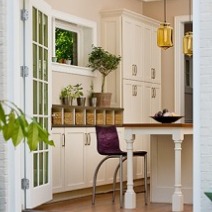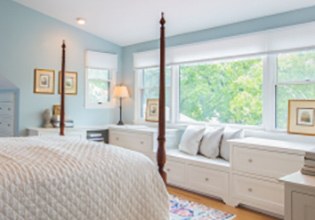Characteristics
Eclecticism, asymmetry, contrast, and even excess were the hallmarks of the Queen Anne style. Every building sported a variety of surface textures. Elaborate motifs decorated gables, spandrel panels and, indeed, almost any flat surface. Newark Street NW in Cleveland Park features many highly decorative examples.
Materials
The Queen Anne look was achieved in a variety of ways with an array of materials that included patterned brick or stone, wood shingles and clapboard, slate, occasionally stucco, and sometimes, terracotta panels. Decorative stone panels were frequently set into the wall, as were custom-molded and colored bricks, allowing some variation and detailing. Wood buildings could assume the full range of color and design with paint.
Roof
Steeply pitched and complex, Queen Anne roofs provided visual interest and variety with gables, dormers, and turrets or towers, often all in one roof.
Towers
Queen Anne towers—square, round, or polygonal—were a favorite feature among architects designing Queen Anne homes. Sometimes instead of a tower, a turret, supported by a corbel, projected from the second floor. The towers and turrets were capped with a conical, tent, domed, or other artfully shaped roof and finished off with slate shingles and a copper finial ornament.
The peak period of the Queen Anne style architecture was 1880–1900, although the style persisted for another decade. The style was named and popularized in England by the architect Richard Norman Shaw (1831-1912) and his followers. The term inaccurately implies aesthetic ideas from the reign of Queen Anne (1702-1714). However, its language was actually based on much earlier English buildings, mainly those constructed during the Elizabethan and Jacobean eras (Elizabeth I reigned 1558–1603; James I, 1603–1625). In 1874–75, the first important expression of the style by an American architect rose in Newport, Rhode Island when H.H. Richardson designed the Watts-Sherman house. But many Americans first saw the Queen Anne style at the Philadelphia Centennial in 1875, where the British government built several houses in that style.







